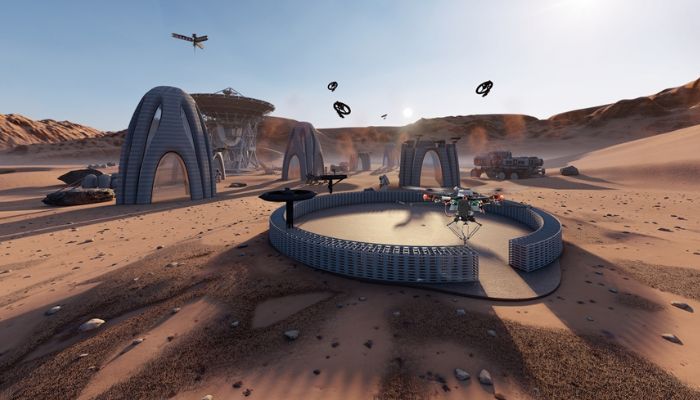
A team of researchers from Imperial College London and Empa, the Swiss Federal Laboratories of Materials Science and Technology have developed a special kind of drone that uses collective building methods and is able to construct and repair buildings. These so-called BuilDrones use in-flight 3D printing and were inspired by the way bees and wasps work in swarms in nature. The new system called Aerial Additive Manufacturing (Aerial-AM) uses multiple drones and once, which will be working together in a fleet from a single blueprint.
In recent years, additive manufacturing has become increasingly popular in the construction sector. Ever since the first 3D-printed houses were constructed just a few years ago, the number of new projects involving AM technologies has been increasing steadily. As more and more companies discover the benefits of AM, the technologies are advancing rapidly as well, as scientists and engineers seek to maximize the technology’s potential. One recent example of that is an impressive new approach to 3Dprinting, which was developed in a collaborative project between Imperial College London and Empa. The team created special drones (BuilDrones), which are able to work autonomously and build or repair houses, replacing human labor, and therefore saving time, costs and minimizing the risk of work-related injuries.

In the future drones could also be used for construction in space (photo credits: Yusuf Furkan KAYA, Aerial Robotics Laboratory, Imperial College London / Empa)
How Aerial-AM and BuilDrones Work
The newly developed drones consist of two different types of flying robots, BuilDrones and ScanDrones. BuilDrones deposit the building materials during flight, whereas ScanDrones are able to monitor and measure the BuilDrones’ output and inform their next manufacturing steps. As earlier mentioned, the workings of the drones can best be compared to bees or wasps building a hive or nest. Although the drones function autonomously in flight, they are monitored by a human controller who is able to monitor their moves and intervene if necessary, ensuring the quality of construction. In addition to that, the Aerial-AM technology uses a 3D printing and path-planning framework, which makes it possible for the drones to adapt to the changing geometry of the structure as the build progresses.
In order to test the drones, the team developed four cement-like mixtures for them to work with. The end result showed that the drones were able to assess the printed geometry in real time and adapt their behavior while printing with an accuracy of five millimeters. Professor Mirko Kovac of Imperial’s Department of Aeronautics and Empa’s Materials and Technology Center of Robotics, who led the project, explained: “We’ve proved the concept that drones can work autonomously and in tandem to construct and repair buildings, at least in the lab. This scalable solution could help construction and repair in difficult-to-reach areas, like tall buildings. We believe our fleet of drones could help reduce the costs and risks of construction in the future, compared to traditional manual methods.”
Aside from the already mentioned cost and time savings, the technology would also enable building construction and repair in high or hard-to-access locations, which would revolutionize the way buildings are being constructed today. To find out more about the drones, you can read the original press release HERE.
*Cover Photo Credits: Imperial College London



